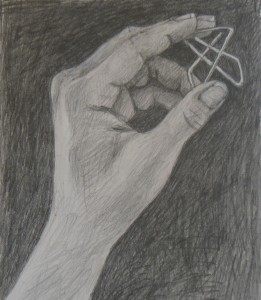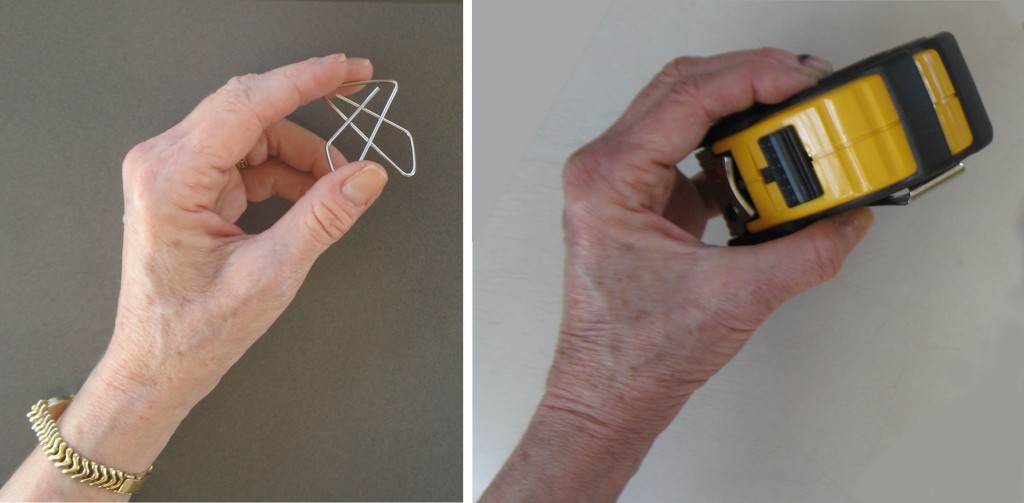
Hand Drawing Tutorial #10 hand pose
It’s always easier to see and draw a small simple shape than a large, complex one.
This is Part 2 of Tutorial #10: Help from a Paper Clip. Part 1 is here.
See the end of this post for a video of this sketch’s “jigsaw puzzle,” which will help you draw this pose – or anything else.
__________
This paper clip pose brings to mind echoes of a teacher – in my early days of drawing lessons – pointing out the need to capture the way the paper clip tucks lightly into thumb and forefinger. To make this drawing convincing, the teacher would explain, parts of the paper clip must seem to disappear into the fingers holding it. If you drew every bit of the paper clip, the teacher would tell us, it wouldn’t look like it’s being held. It would look like the paper clip had been plopped down on top of your drawing of a hand.
What’s distinct about holding a paper clip?
The teacher would also have explained that a hand looks different when holding a light, delicate paper clip than gripping something heavy. In a hand with a paper clip, muscles don’t bulge, veins don’t pop, nothing is under strain. Only one finger plus the thumb are needed to support the light weight, so the other three fingers just float into resting positions.
In contrast, see the photo below of my hand with a tape measure. Here my fingers are working differently to bear the greater weight than when I’m holding the paper clip. Can you spot some of the differences?

Can you spot the differences in hand and finger position holding a paper clip vs holding a tape measure? How many fingers are needed to support the weight of each object? Is the hand relaxed or tense?
My three largest fingers are all needed to handle the weight of the tape measure. And the pinky is balancing it from behind. My thumb is straining awkwardly to do its part.
Meanwhile the hand with the paper clip looks as relaxed as a hand model in an ad for some product.
How do we convincingly draw a hand grasping a paper clip vs a small heavy item?
It can be entertaining and instructive to puzzle through how a hand looks different holding a nearly weightless object vs a heavy one. I encourage you to constantly observe this kind of visual distinctions in the world around you. That way you’ll build up your store of visual knowledge, which will unconsciously help improve your drawing.
But when you begin to draw, you need to put those observations on your mind’s back burner in order to focus only on what you’re seeing in your model. You need to engage your “right-brain” mode function, which apprehends spacial relationships, shapes, colors, and shadows with lightning speed and good accuracy.
Thinking consciously about your knowledge store while you draw instead engages “left brain” function – the comparatively lumbering, verbal mode of brain work. Avoid debating knowledge when you’re drawing.
Simply look at the jigsaw puzzle of shapes in front of you. Figure out their sizes, shapes, and how they fit together – because drawing small, simple shapes is always easier than drawing large or complex ones. So you need to learn to see your model in small, simple pieces.
Drawing via “right-mode” vision is an easier, more all-purpose way to draw from life than is over-thinking. With this method, you can draw accurately from life regardless of your subject – whether your hand is gripping a feather or a 100-lb. weight.
How can you reliably engage your right-mode vision?
Earlier posts have described my jigsaw puzzle metaphor for “right-brain” drawing. My jigsaw metaphor seems to be the most helpful way I’ve found so far of explaining this technique (elsewhere I’ve described it as e. g. an “angle abstraction game.”) I’ve found myself using game metaphors because when you get into this mode, drawing becomes like a game or puzzle. You’re making decisions about what to draw with split-second speed, completely non-verbally. You’re in the zone.
So to me, teaching some one to draw above all means teaching them how to see in right-mode. Shifting to seeing via this non-standard brain-mode is easy once you “get it,” but sometimes hard before that. To try another way of helping you make that shift, in this post I’m doing something slightly different for the video. I’ve started with a photograph of my hand in the Tutorial 10 Paper Clip pose which I drew in my last post‘s video (scroll down that post to watch the video of that drawing, with written commentary keyed to specific frames).
Jigsaw video of this hand pose
Below, on top of the photo of my hand, I’ve superimposed what I was envisioning in my mind’s eye as I was drawing.
- Each black line represents a line I actually drew.
- Each colored shape represents a “jigsaw” piece as I saw it in my mind’s eye.
- Each chartreuse line is an imaginary or actual guideline for a relationship to other pieces that I was using to check the size and shape of pieces I was drawing.
- Each pale gray shape is one that I pictured in my mind’s eye to help me draw something next to it.
Note that I put my puzzle pieces together in an order that made sense to my right-mode vision – that is, shapes that fit together visually regardless of which object they were part of. I did not focus on completing all the fingers at once for example, or the entire paper clip at one time. In fact I finished the final shape of the paper clip at almost the end of the drawing.
Does this type of video help you with your drawing? Email or leave a comment below to let me know what works best for you.
{"numImgs":"47","constrain":"height","cvalue":"420","shellcss":"width:675px;padding:4px;margin:14px auto 0;"}
Learning to draw requires effort and practice. But it’s also like a game, with potentially satisfying and fun results.




















Hi there, just became aware of your blog through Google, and found that it is truly informative. I am going to watch out for brussels. I’ll appreciate if you continue this in future. A lot of people will be benefited from your writing. Cheers!
online gambling slots games free online gambling
Hi, after reading this awesome piece of writing i am too happy to sharemy familiarity here with mates.
cheap tadalis generic tadalafil 20mg generic voltaren 50mg
Thanks for the article post.
Major thanks for the blog.Much thanks again. Really Cool.
Thank you ever so for you blog article.Much thanks again.
Your style is so unique in comparison to other people I have read stuff from. Thank you for posting when you’ve got the opportunity, Guess I will just book mark this blog.
isotretinoin 20mg us order generic isotretinoin 20mg order zithromax 500mg without prescription
Good replies in return of this query with firm arguments and explaining thewhole thing regarding that.
indomethacin 75mg tablet brand indomethacin 75mg brand trimox
I really enjoy the article. Awesome.
Very informative article.Thanks Again. Want more.
order cialis 40mg Pfizer viagra 50mg real viagra